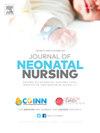在三级医疗保健中心实施 "吃、睡、控制 "法
Q2 Nursing
引用次数: 0
摘要
自阿片类药物危机在美国开始以来,出生后经历新生儿阿片类药物戒断综合征(NOWS)的婴儿一直是一个重大的公共卫生问题。传统的症状管理评估工具历来导致长时间住院和出生后继续暴露于阿片类药物治疗。目的:在一家大型城市儿童医院妇产中心的新生儿重症监护室实施“睡眠、控制台”(ESC),以取代流行的NOWS评估工具。目的是确定使用ESC是否会减少住院时间、吗啡的使用以及增加产后直接出院的人数。结果salos由9.2天减少到6.2天,减少33%。吗啡治疗起始率从21.7%下降到3.8%,下降了82.4%。两组都不包括接受二线药物治疗的婴儿。最后,直接从产后单位出院率提高了47%。使用ESC, NOWS患儿管理的所有确定结果均得到改善。大规模使用ESC可能对这类患者群体有多种益处,包括降低医疗成本和延长出生后对阿片类药物的暴露时间,以及在产后立即保存母婴二联体。需要进一步研究ESC方法的长期影响。本文章由计算机程序翻译,如有差异,请以英文原文为准。
Implementing the eat, sleep, console method into a tertiary care delivery center
Background
Infants experiencing Neonatal Opioid Withdrawal Syndrome (NOWS) after birth has been a significant public health issue since the opioid crisis began in the U.S. Traditional assessment tools for symptom management have historically resulted in prolonged hospitalization and continued exposure to opioids after birth to treat them.
Purpose
Eat, Sleep, Console (ESC) was implemented to replace a popular NOWS assessment tool in a neonatal intensive care unit at a large urban children's hospital's maternity center. The aim was to determine whether using ESC would decrease length of hospitalization, use of morphine for treatment, as well as increase the number of direct discharges from the postpartum unit.
Results
ALOS decreased from 9.2 days to 6.2 days, a 33% reduction. Morphine treatment initiation decreased from 21.7% to 3.8%, an 82.4% reduction. Neither group included infants treated with a second line medication. Finally, the discharge rate improved by 47% directly from the postpartum unit.
Conclusions
Using ESC, all identified outcomes regarding management of infants with NOWS improved. Wide-scale use of ESC could have multiple benefits for this patient population including a reduction in healthcare costs and prolonged exposure to opioids after birth, as well as preservation of the mother-infant dyad in the immediate postpartum period. Further research is needed to study the long-term impact of the ESC method.
求助全文
通过发布文献求助,成功后即可免费获取论文全文。
去求助
来源期刊

Journal of Neonatal Nursing
Nursing-Pediatrics
CiteScore
2.00
自引率
0.00%
发文量
143
期刊介绍:
Aims & Scope: This is the practical, bimonthly, research-based journal for all professionals concerned with the care of neonates and their families, both in hospital and the community. It aims to support the development of the essential practice, management, education and health promotion skills required by these professionals. The JNN will provide a forum for the exchange of ideas and information between the range of professionals working in this field; promote cooperation between these professionals; facilitate partnership care with families; provide information and informed opinion; promote innovation and change in the care of neonates and their families; and provide an education resource for this important rapidly developing field.
 求助内容:
求助内容: 应助结果提醒方式:
应助结果提醒方式:


